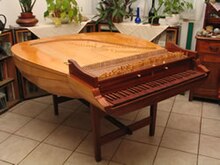Lute piano
The lute piano or lute clavicon is a keyboard instrument from the Baroque music period , similar to the harpsichord . The strings are not made of metal, but of (double) gut strings. This makes the lute piano sound softer than a harpsichord. There should also have been combinations of two registers of gut stringing and one register made of metal.
Johann Sebastian Bach , who owned two such instruments (one of which he had Hildebrand built for himself in 1740) and the writer of an addition to Bach's E minor suite (BWV 996) also referred to the lute piano as a Lautenwerck .
While there are various references to this instrument in the literature, no original playable lute piano has survived. However, there are some more recent replicas. A large part of the historical information is based on three German instrument makers of the 18th century: Johann Christoph Fleischer from Hamburg, Johann Nicolaus Bach and Zacharias Hildebrandt .
literature
- Thomas Schmitt: Johann Sebastian Bach's works for lute. In: Guitar & Laute 7, 1985, No. 6, pp. 13-20; here: p. 19 f. ( Das Lautenklavier ), 8, 1986, issue 1, p. 26 f. and 64 f .; here: pp. 27 and 64. ( summary ).
Web links
- http://www.baroquemusic.org/barluthp.html
- Listening example: Fugue in G minor for lute piano BWV 1000
- Audio sample on http://keithhillharpsichords.com [1] (MP3; 2.8 MB)
Individual evidence
- ^ Hans Dagobert Bruger: Johann Sebastian Bach, compositions for the lute. First complete and critically reviewed edition. Transcribed and edited from old source material for today's lute. 1921; 3. Edition. Julius Zwißlers Verlag (owner Georg Kallmeyer), Wolfenbüttel 1925; Reprinted by Karl Heinrich Möseler Verlag, Wolfenbüttel / Zurich, p. 51.
